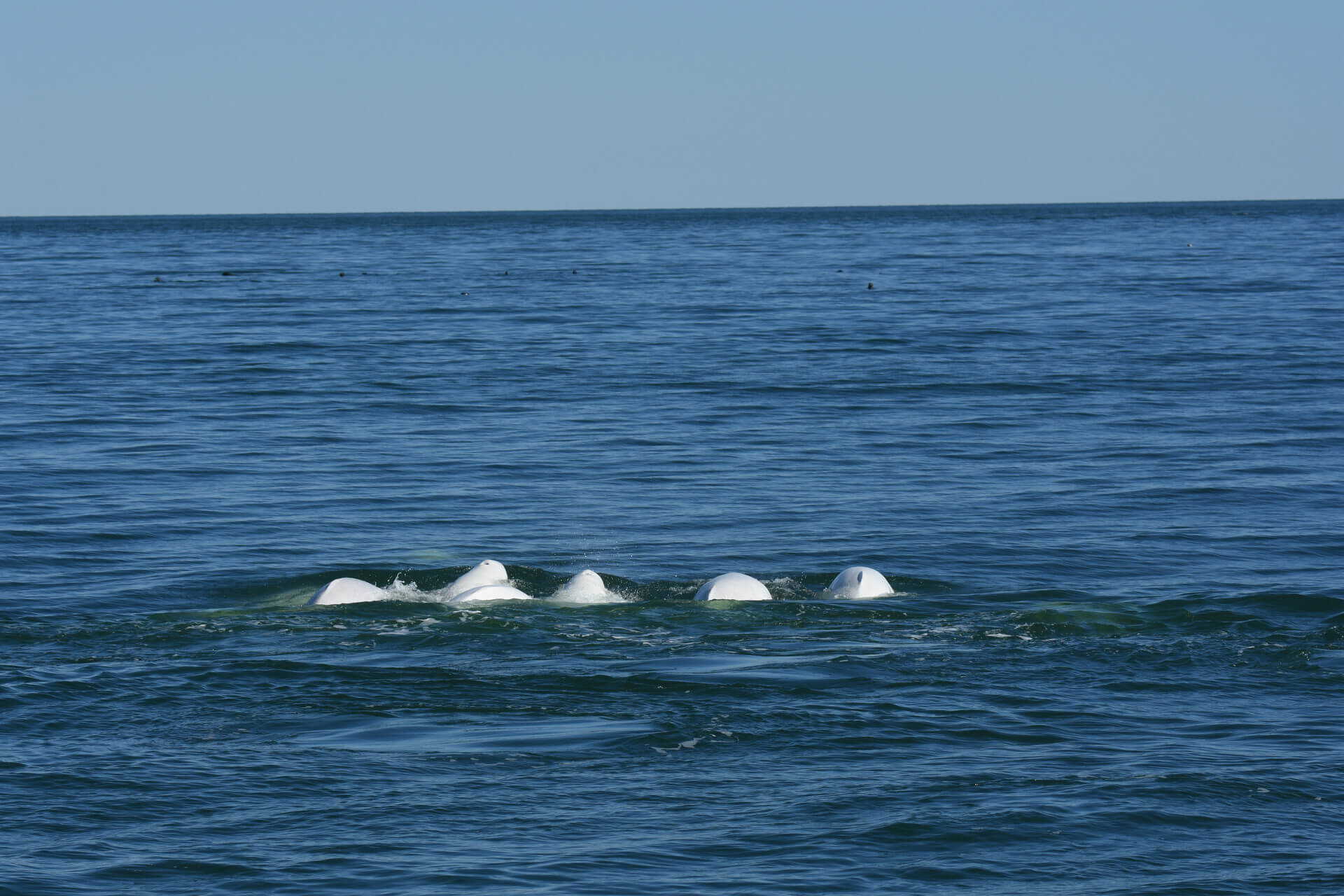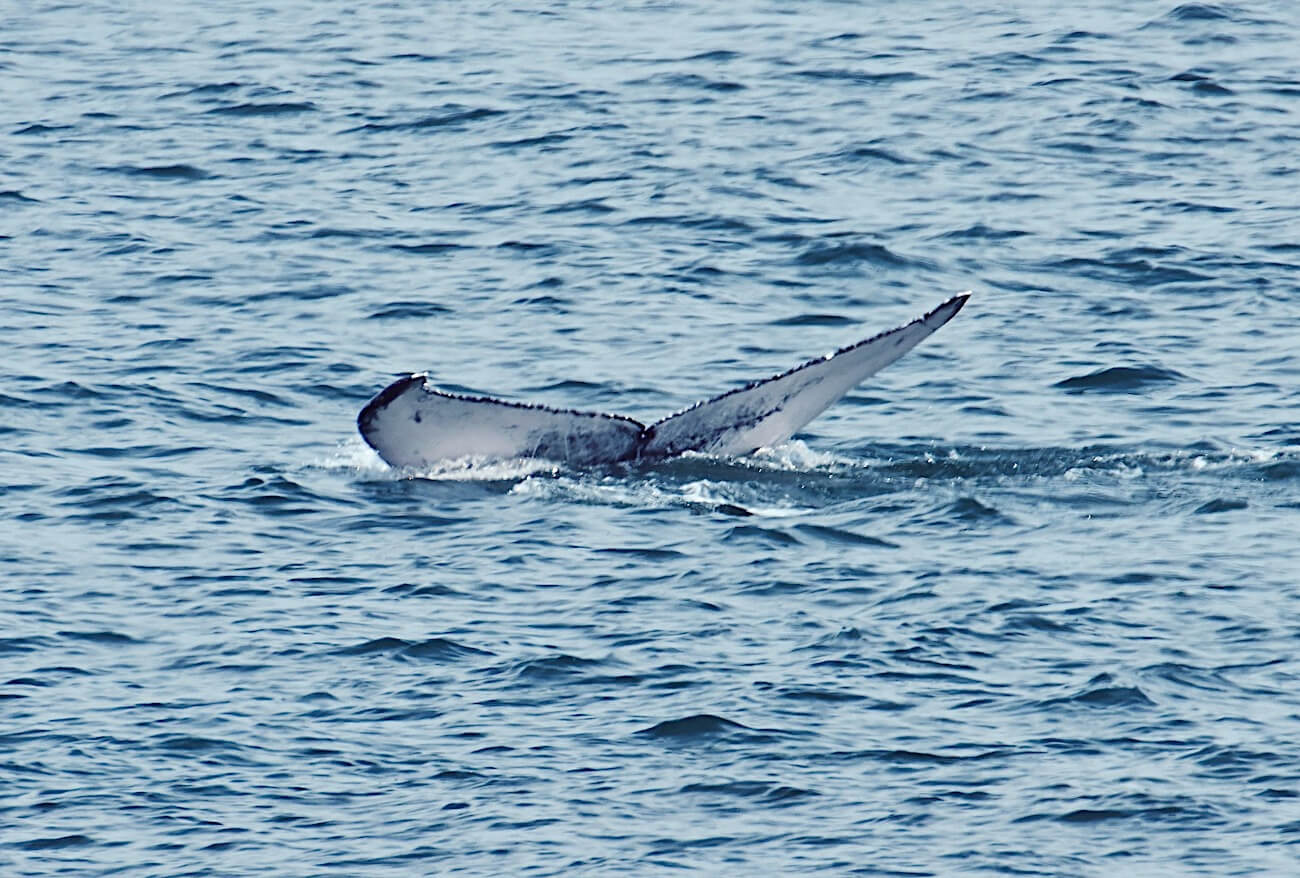This past week, belugas have been seen from both shores of the estuary. Humpbacks, minke whales and seals were also present. However, this past week it’s migratory birds that are stealing the spotlight from marine mammals. Walking along the water’s edge, it’s hard not to be distracted by the wing beats of colourful birds!
The only cetacean present year round in the St. Lawrence migrates within its range in spring and fall. Just like she does every year in late April, a resident of Rivière-Ouelle observed a few belugas from the marina. She snaps a few photos and notes the markings on the dorsal crest of one of them. Could they be used to make an ID?
Indeed, the presence of natural marks such as pigmentation, colouring or the presence of scars are very useful in identifying individuals. There were also several other belugas. “That one was accompanied by a young, still grey individual,” she explains. The group also contained at least four other belugas, including another female with a calf.” To identify individual belugas, however, teams from the Group for Research and Education on Marine Mammals (GREMM) take photos from a specific angle. The photos are carefully analyzed, compared to those of several individuals and matched according to a rigorous set of criteria!
The presence of a few belugas was also reported in Rivière-au-Renard. A research assistant accompanying a Fisheries and Oceans Canada vessel also saw several white whales during a day in the field: “Most of them were in pairs or small groups (up to 5 individuals at most as far as I remember) and very scattered. The animals were taking long dives and not taking many breaths in-between […].” On the north shore of the river, an observer spotted a large beluga swimming in the mouth of the fjord last Sunday, while a dozen or so individuals were tallied from Pointe-Noire the same day.
Rorquals small and large
In the Franquelin area, two humpbacks and two minke whales were reported. Offshore, a large blast was a bit of a head-scratcher, but there were no other signs of fin or blue whales this week. Around Sept-Îles, two harbour seals were seen on rocks in the bay in their famous “banana” position.
A minke whale was spotted by a marine mammal enthusiast in Essipit. Also in the area, a photographer and naturalist had the chance to observe a humpback whale. He first spotted it from the wharf in Les Bergeronnes heading northeast along the coast. Taking a chance, he headed toward Cap de Bon-Désir to see if he could relocate the whale there. “The bet paid off,” he says. About an hour and 15 minutes after the initial observation, I spotted the individual again, blowing and diving right in front of me… I was able to take these dream shots, my first photos of a humpback for 2024! […].”
Migrating birds
Up and down the St. Lawrence, the diversity of seabirds frequenting its coastal ecosystems is on the rise: common eiders, scoters, long-tailed ducks, brant and more. Outside Tadoussac’s Marine Mammal Interpretation Centre were several snow buntings, a species that nests in the Arctic.
The Tadoussac Bird Observatory even issued a friendly alert to birders on its social networks. From sparrows to kinglets, robins to blackbirds, a wide array of Quebec’s birdlife was observed in numbers. Depending on weather conditions, movements could even be significant. “But what could be even more exceptional is the depression expected in the early morning in the Côte-Nord region with northwesterly winds, falling temperatures and precipitation. These are the perfect conditions for a reverse migration!” Since 1993, the team has documented the migrations of more than one hundred species through the use of visual surveys.
Thanks to all our collaborators!
Special thanks go out to all our observers who share their love for marine mammals with us! Your encounters with cetaceans and pinnipeds are always a pleasure to read and discover.
On the water or from shore, it is your eyes that give life to this column.
Claude Auchu
Odélie Brouillette
Patrice Corbeil
Laetitia Desbordes
Véronique Gélinas
Diane Ostiguy
Mathieu Marzelière
Renaud Pintiaux
Pascal Pitre
Andréanne Sylvain
Marielle Vanasse
Et à tous les autres!
Merci aussi aux équipes qui partagent leurs observations :
Station de recherche des Îles Mingan (MICS)
Réseau d’observation des mammifères marins (ROMM)
Réseau québécois d’urgence pour les mammifères marins (RQUMM)
Groupe de recherche et d’éducation sur les mammifères marins (GREMM)
And all those we left out!
Additionally, we would like to acknowledge the following teams that also share their sightings:
Mingan Island Cetacean Study (MICS)
Marine Mammal Observation Network (ROMM)
Quebec Marine Mammal Emergency Response Network (QMMERN)
Group for Research and Education on Marine Mammals (GREMM)
Would you also like to share your observations?
Have you seen any marine mammals in the St. Lawrence? Whether it’s a spout offshore or just a couple of seals, drop us a line and send your photos to [email protected]!







